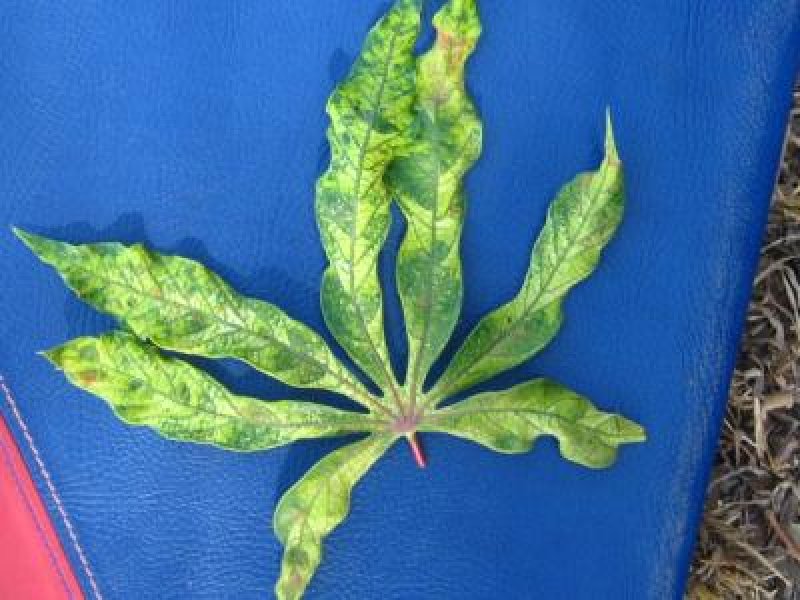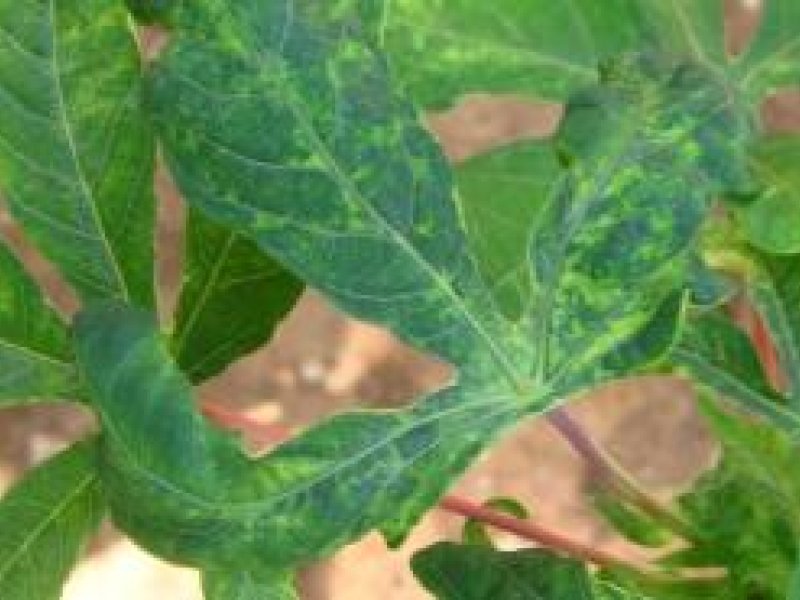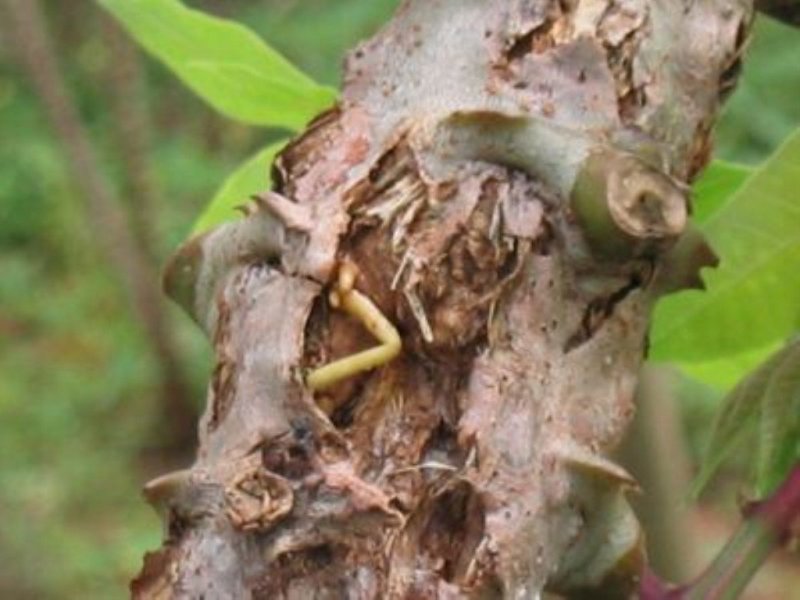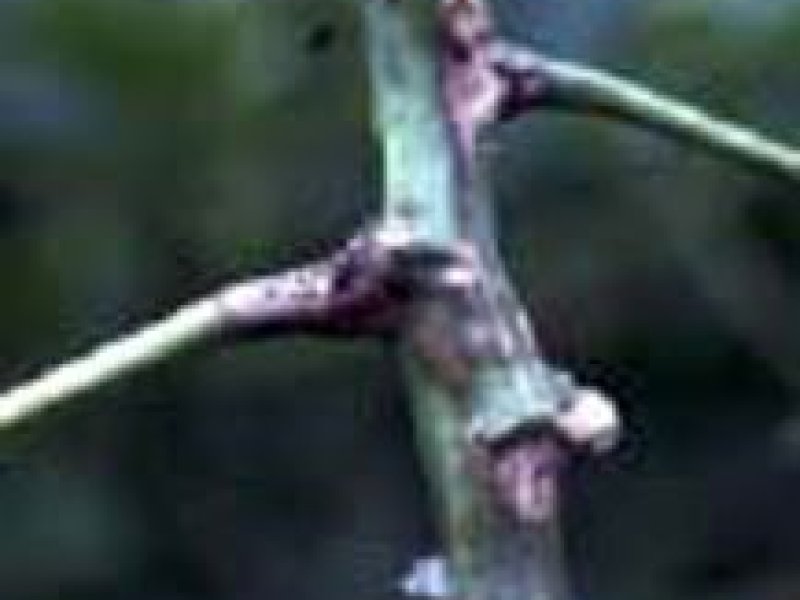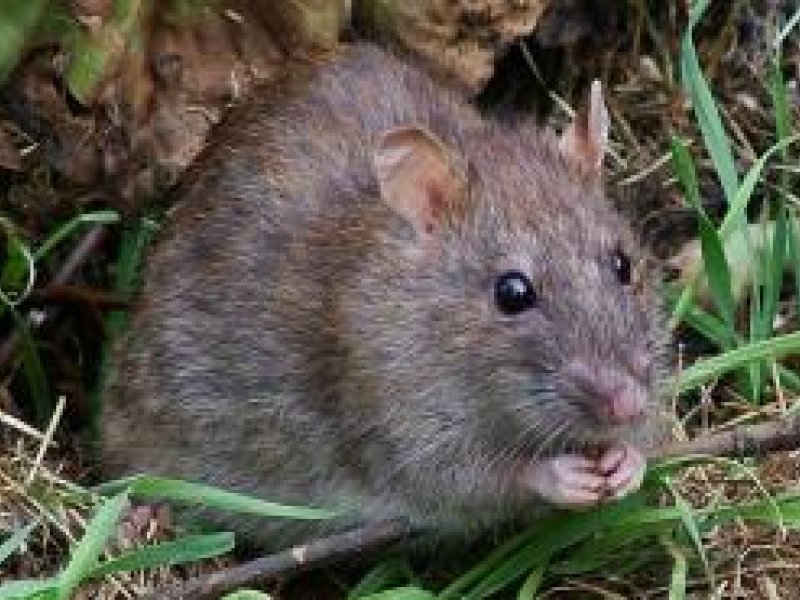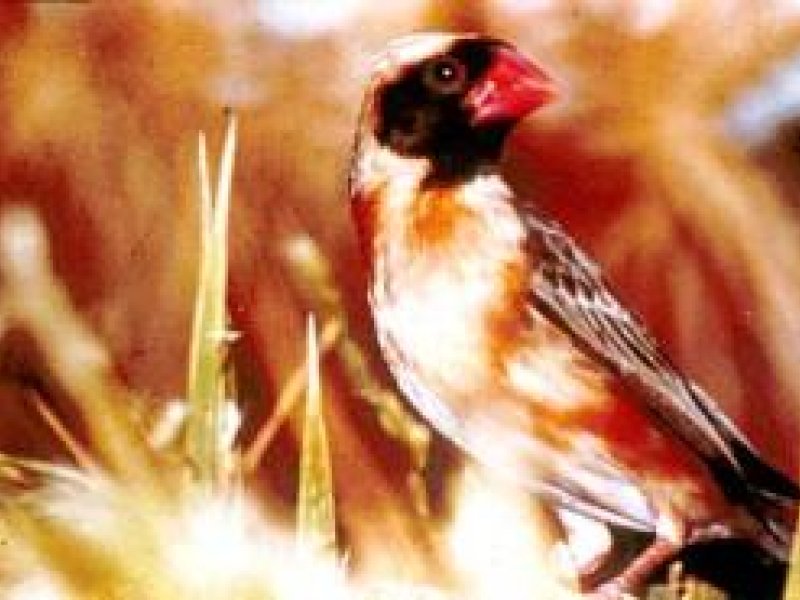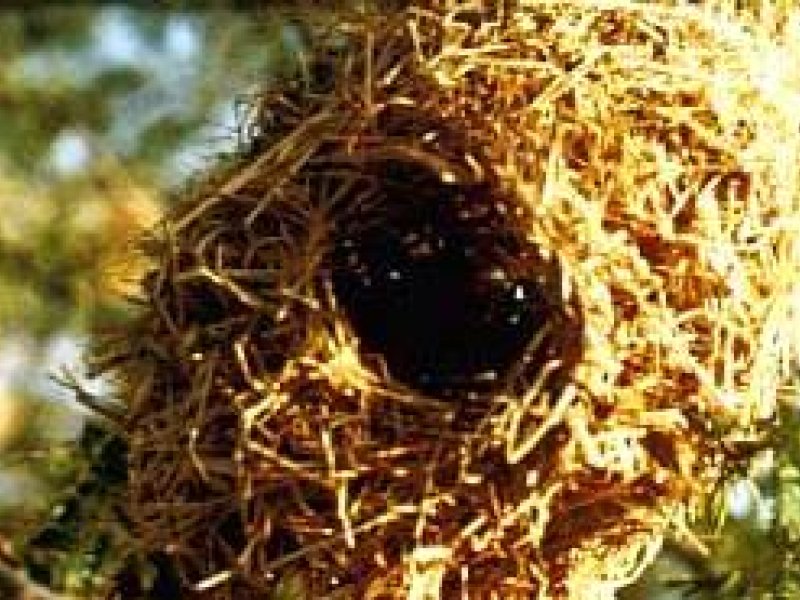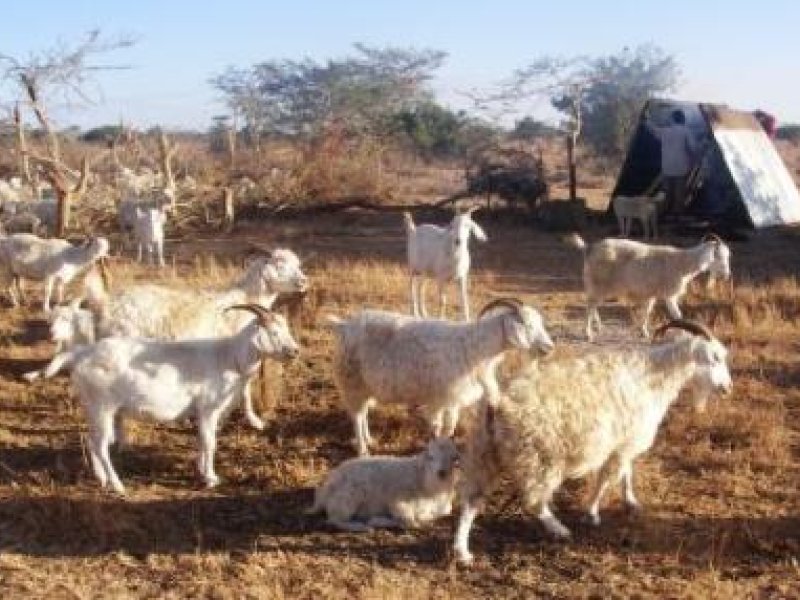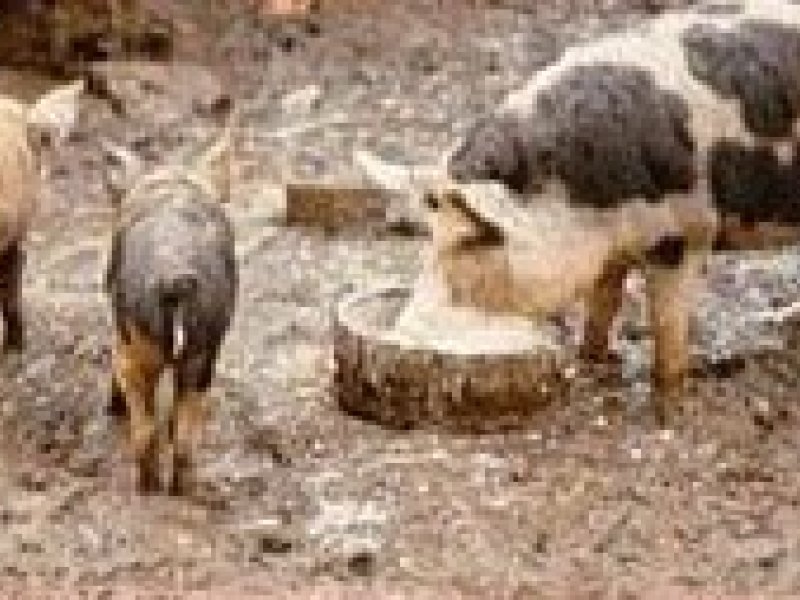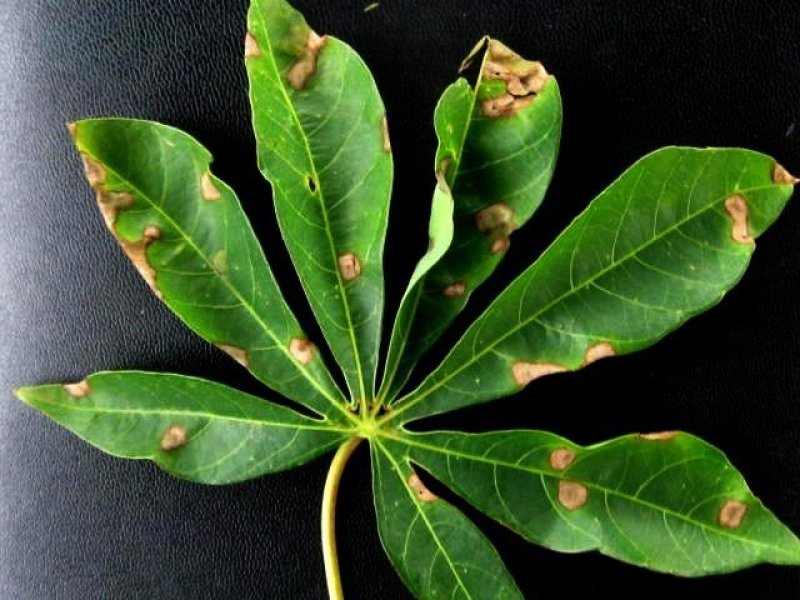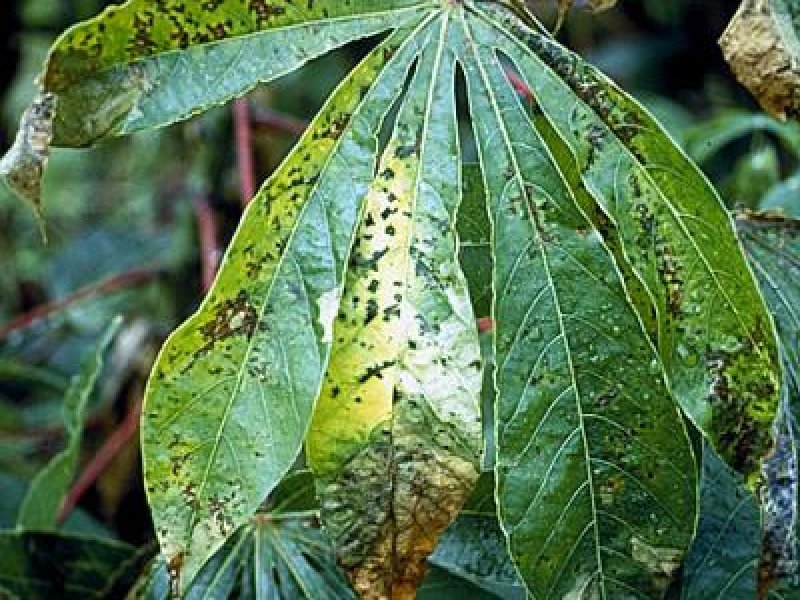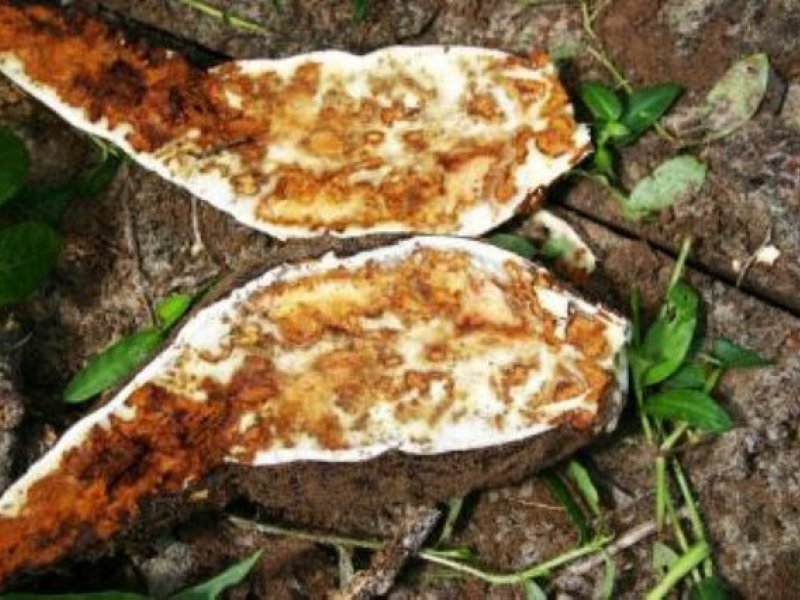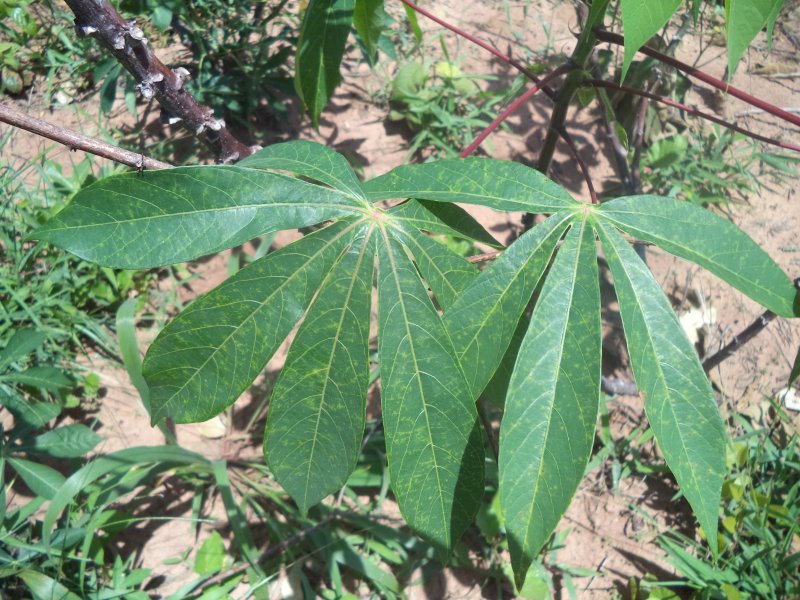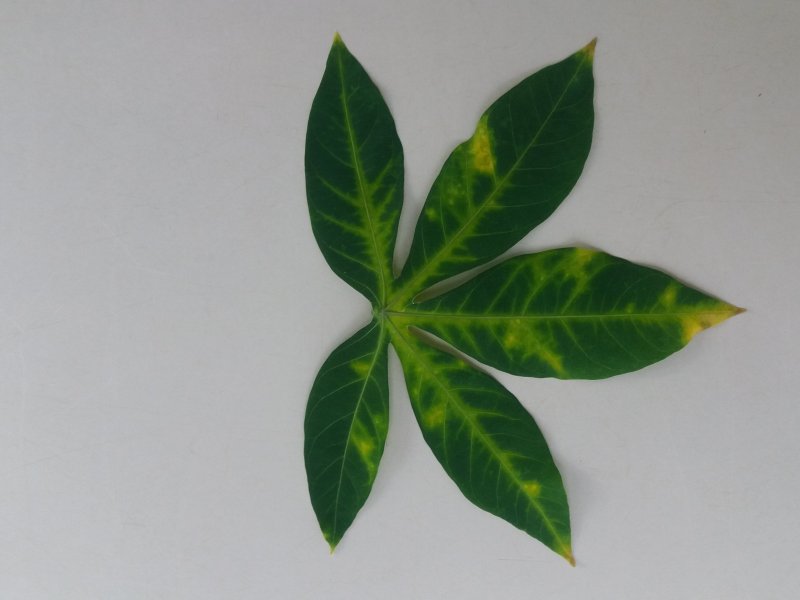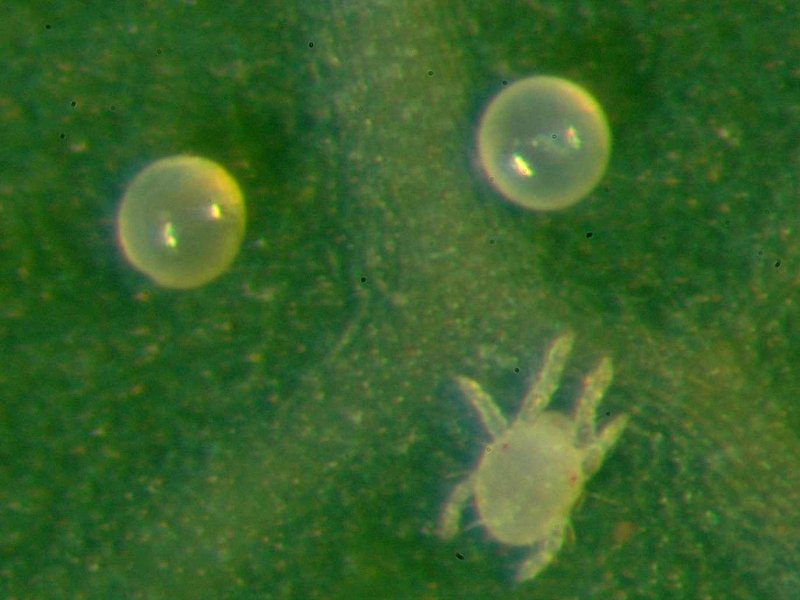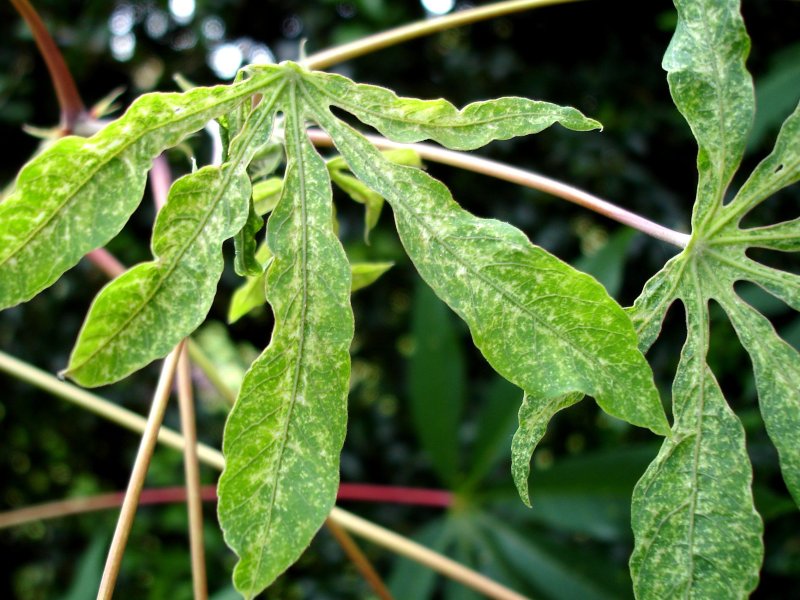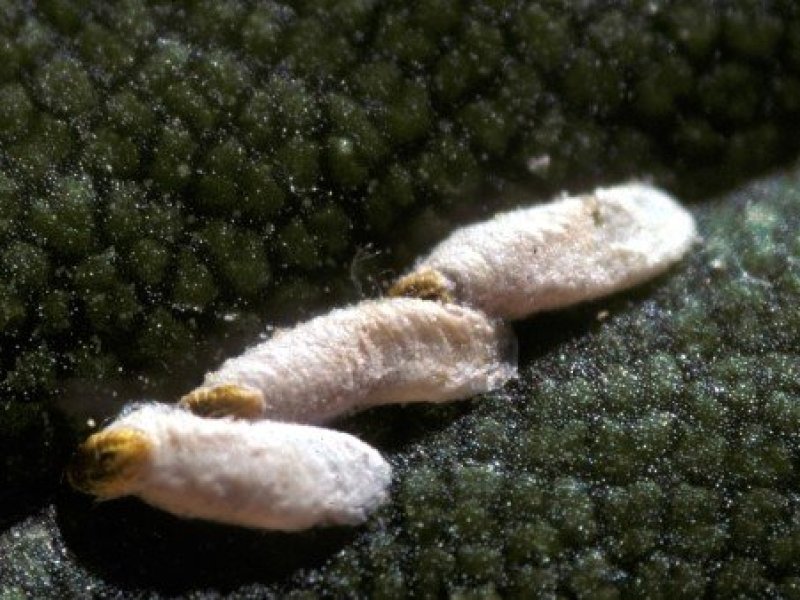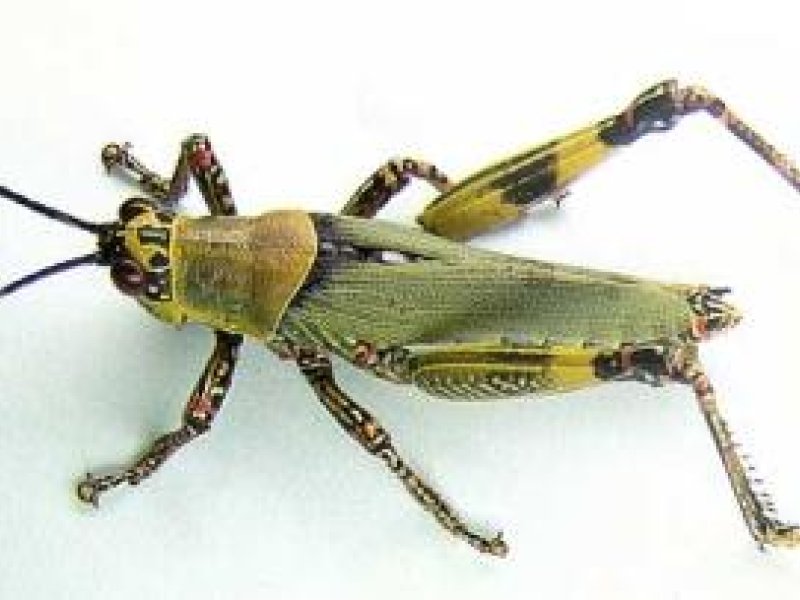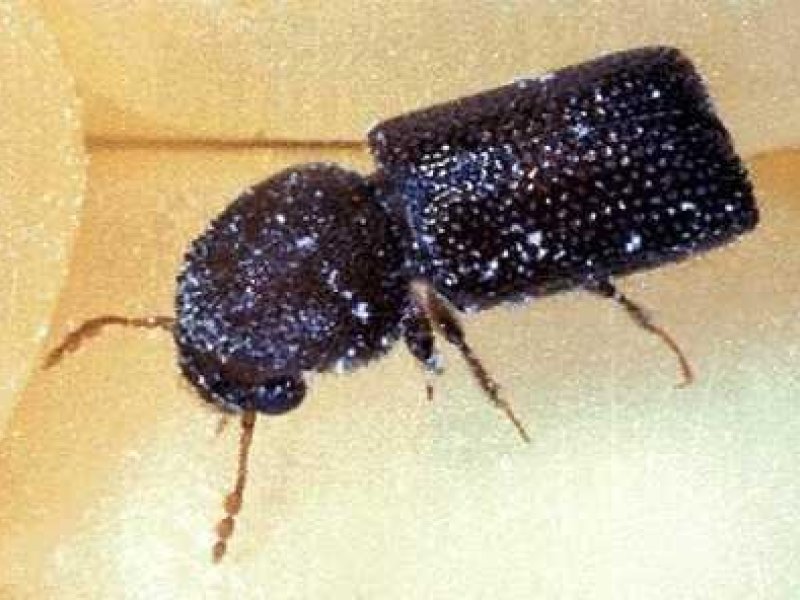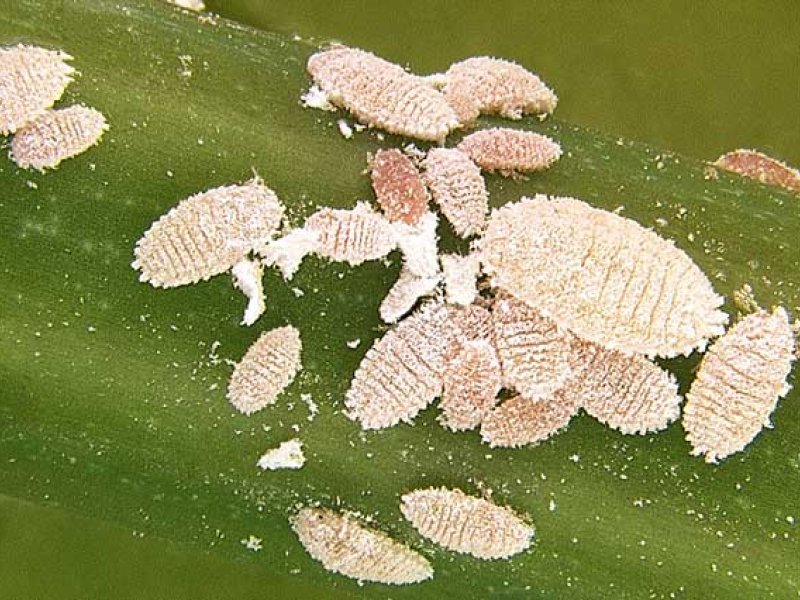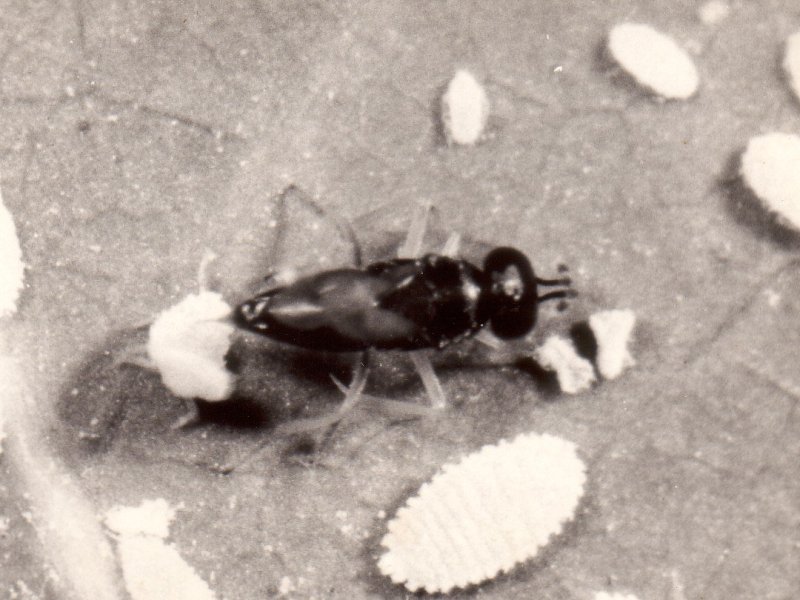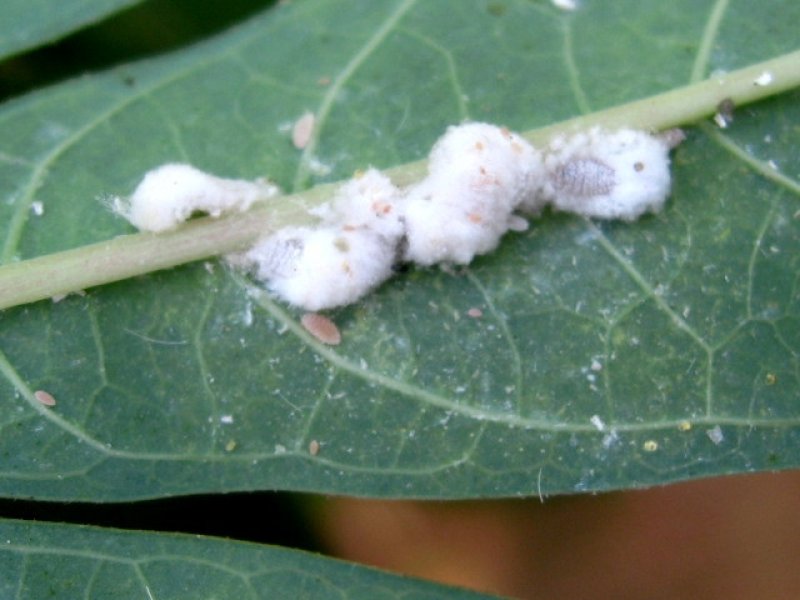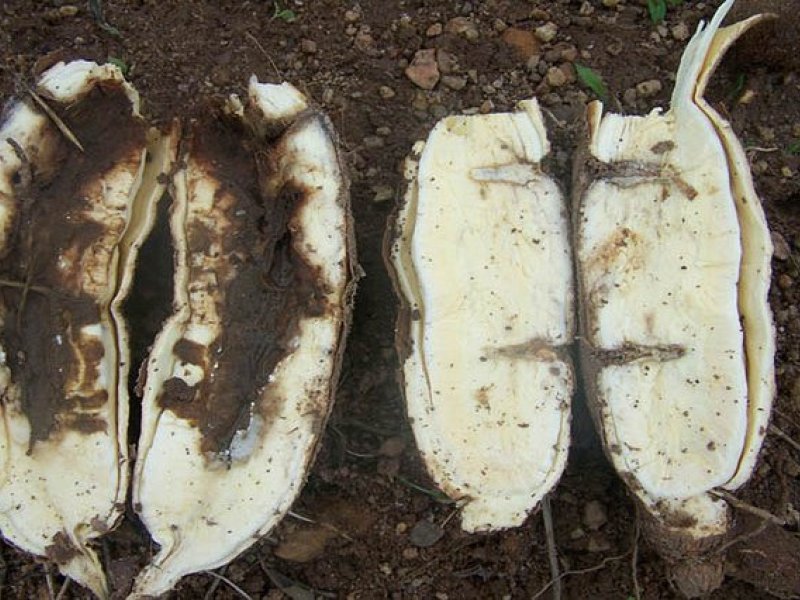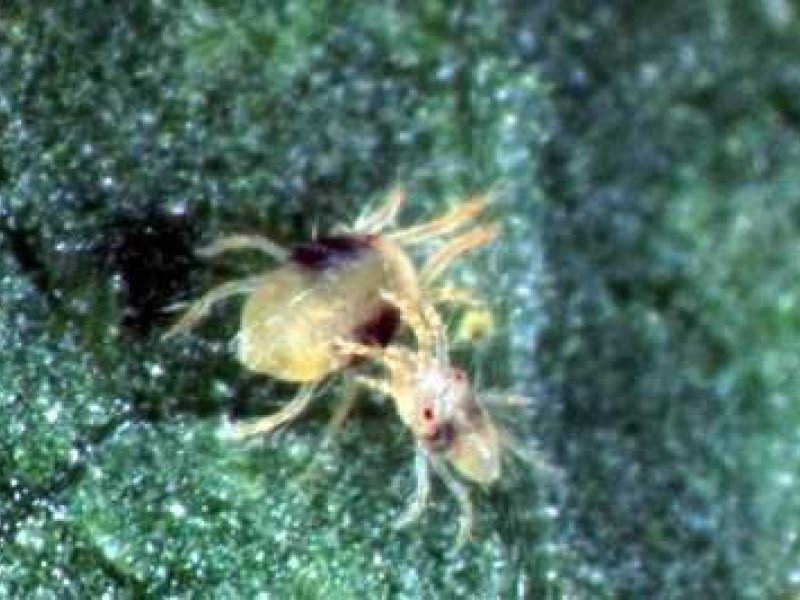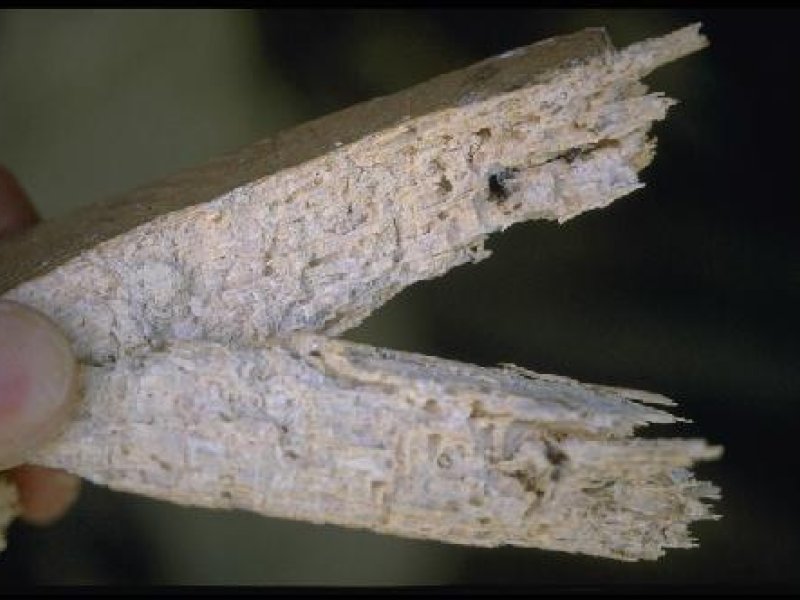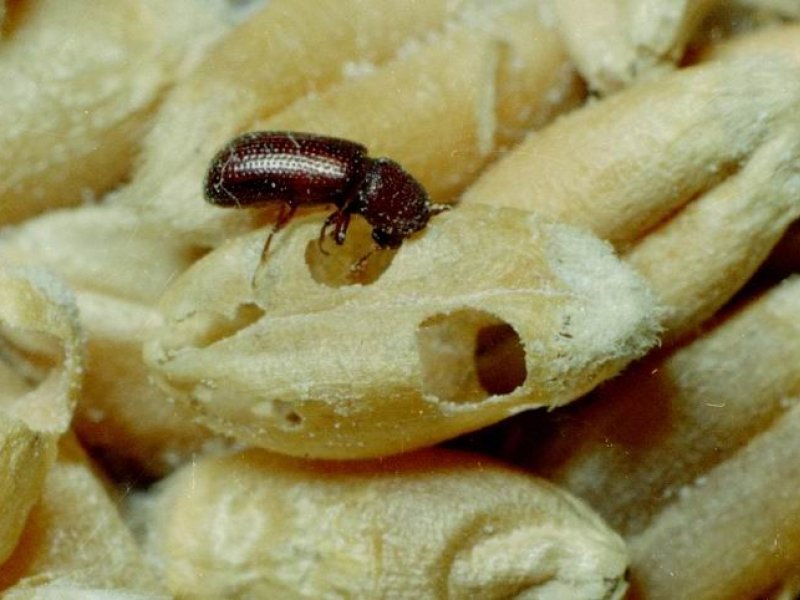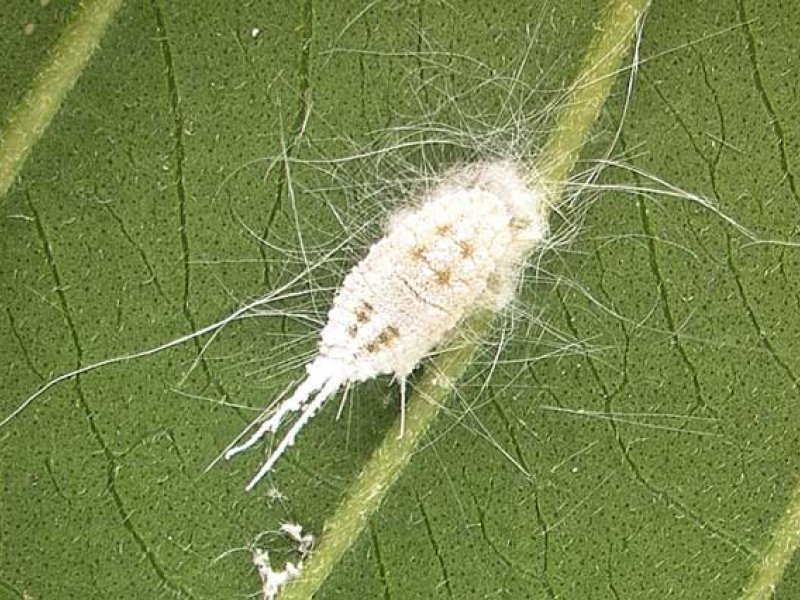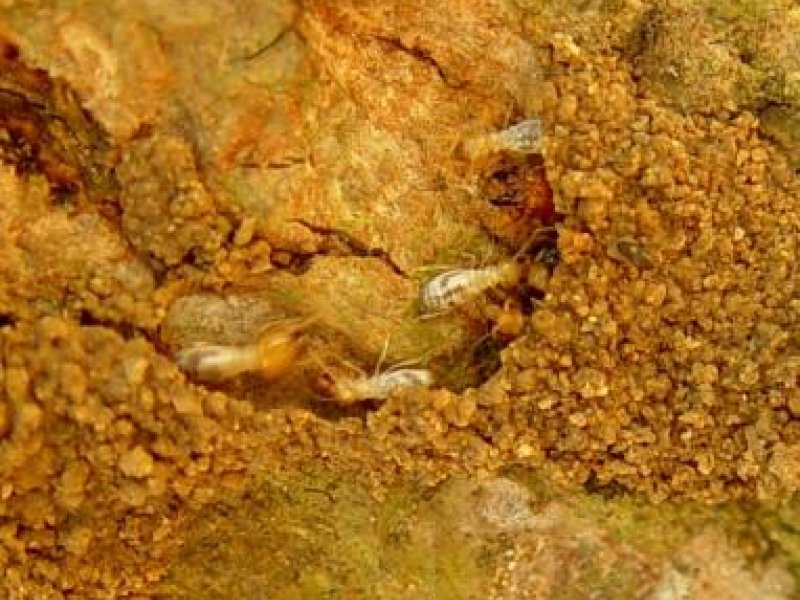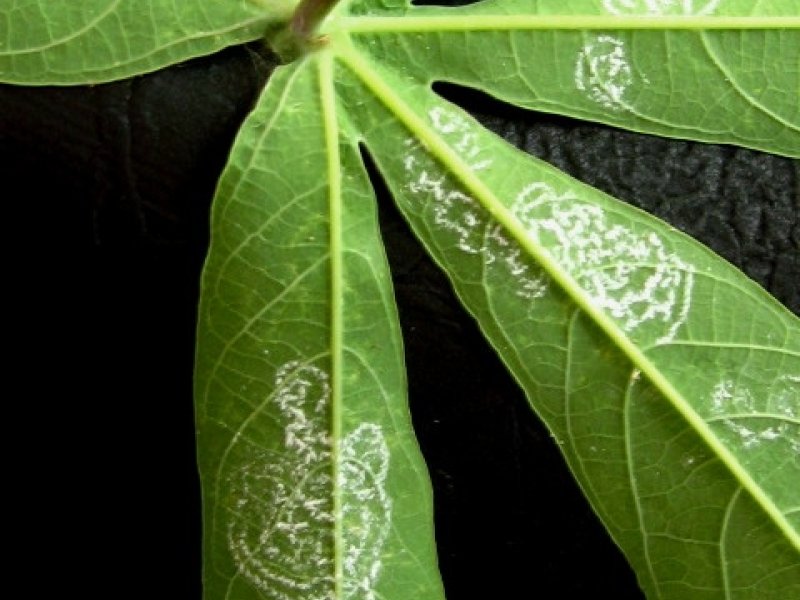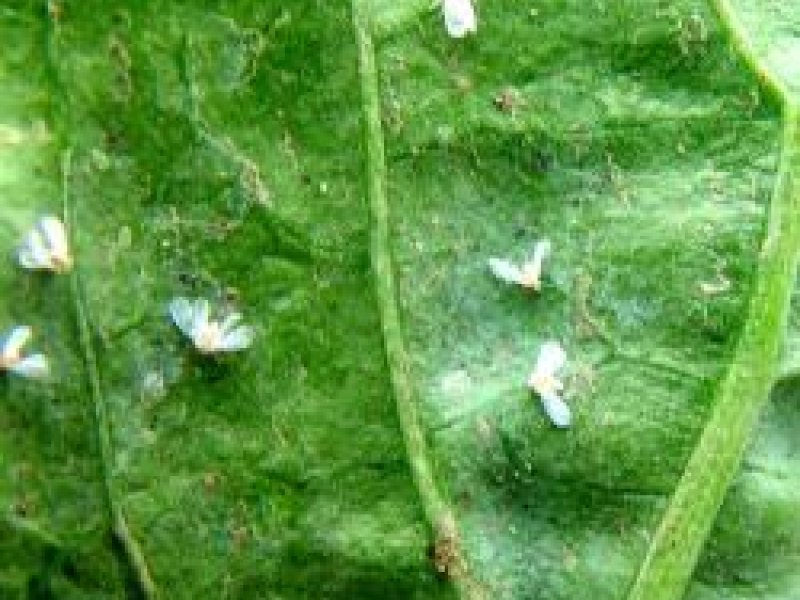|
African Cassava Mosaic Disease (ACMD) African cassava mosaic disease is one of the most serious and widespread diseases throughout cassava growing areas in Africa, causing yield reductions of up to 90%. It is spread through infected cuttings and by whiteflies (Bemisia tabaci).
Symptoms occur as characteristic leaf mosaic patterns that affect discrete areas and are determined at an early stage of leaf development. Symptoms vary from leaf to leaf, shoot to shoot and plant to plant, even of the same variety and virus strain in the same locality. Some leaves situated between affected ones may seem normal and give the appearance of recovery. |
|
|
What to do:
|
|
Anthracnose (Glomerella manihotis) Initial symptoms of the disease are oval lesions ("sores") on young stems. On older stems, raised fibrous lesions develop that eventually become sunken.
|
|
|
What to do:
|
|
Birds and other vertebrate pests Birds, rodents, monkeys, pigs and domestic animals (cattle, goat and sheep) are common vertebrate pests of cassava.
Measures that help to manage damage by these pests include: |
|
|
What to do:
|
|
Brown leaf spot (Cercosporidium henningsii) Symptoms are restricted to older leaves. Brownish round spots with definite borders appear on the upper leaf surface. On the lower leaf surface, they are brownish-grey in colour. Infected leaves later become yellow and eventually drop. In wet areas the disease may cause a yield reduction of up to 20%. |
|
|
What to do:
|
|
Cassava bacterial blight (Xanthomonas campestris pv. manihotis) It is a major constraint to cassava cultivation in Africa. Infected leaves show localised, angular, water-soaked areas. Under severe disease attack heavy defoliation occurs, leaving bare stems, referred to as "candle sticks". Since the disease is systemic, infected stems and roots show brownish discolouration. During periods of high humidity, bacterial exudation (appears as gum) can readily be observed on the lower leaf surfaces of infected leaves and on the petioles and stems. The disease is favoured by wet conditions. This disease is primarily spread by infected cuttings. It can also be mechanically transmitted by raindrops, use of contaminated farm tools (e.g. knives), chewing insects (e.g. grasshoppers) and movement of man and animals through plantations, especially during or after rain. Yield loss due to the disease may range from 20 to 100% depending on variety, bacterial strain and environmental conditions. |
|
|
What to do:
|
|
Cassava brown streak virus disease (Potyvirus - Potyviridae) It is particularly serious in coastal areas of Kenya, Zanzibar, Mozambique and Tanzania and lakeshore region of Malawi and in Uganda and is a threat to the whole of sub-Saharan Africa. The virus is vectored by whiteflies (Bemisia spp.) and also transmitted through infected cuttings. Symptoms include yellowing (leaf chlorosis) and brown streaks in the stem bark (cortex). Infected tubers have brown streaks (root necrosis) (Field Crops Technical Handbook, MoA, Kenya). It's a stealth virus, which destroys everything in the field. The leaves may appear healthy even when the roots have rotted away.
|
|
|
What to do:
|
|
Cassava green spider mite (Mononychellus tanajoa or M. progresivus) This mite is green in colour at a young age turning yellowish as adult. Adult females attain a size of 0.8 mm. They appear as yellowish green specks to the naked eye. They occur on the lower surface of young leaves, green stems and auxiliary buds of cassava. Damage initially appears as yellowish "pinpricks" on the surface of young leaves.
Symptoms vary from a few chlorotic spots to complete chlorosis. These symptoms are somehow similar to African cassava mosaic disease, and should not be confused. Heavily attacked leaves are stunted and become deformed. Severe attacks cause the terminal leaves to die and drop, and the shoot tip looks like a "candle stick". Green spider mites are major pests in dry season. Severe mite attack results in 20-80 % loss in tuber yield.
Predatory mites (mainly Typhlodromalus aripo and T. manihoti) introduced from South America, the home of the cassava green mite, have given effective control of the cassava green mites in Africa (Yaninek and Hanna, 2003).
|
|
|
What to do:
|
|
Cassava scales (Aonidomytilus albus) It is a mussel-shaped scale with an elongated silvery-white cover and about 2-2.5 mm long. This scale may cover the stem with conspicuous white secretions, and eventually the leaves. This scale sucks from the stem and dehydrates it. The leaves of attacked plants turn pale, wilt and drop off. Severely attacked plants are stunted and yield poorly. Scale attack can kill cassava plants, in particular plants weakened by previous insect attack and drought. Stem cuttings derived from infested stem portions normally do not sprout. |
|
|
What to do:
|
|
Grasshoppers (Zonocerus variegatus) Grasshoppers such as the variegated grasshopper (West to East Africa south of the Sahara), and the elegant grasshopper (Z. elegans) (Southern Africa and East Africa) are brightly coloured grasshoppers.
Adults are dark green with yellow, black and orange marking on their bodies. Nymphs are black with yellow markings on the body, legs and antenna and wing pads. Female grasshoppers lay many eggs just below the surface of the soil in the shade under evergreen plants, usually outside cassava fields. Eggs are laid in masses of froth, which harden to form sponge-like packets, known as egg pods, which look like tiny groundnut pods. Eggs start to hatch at the beginning of the main dry season.
Grasshoppers attack a wide range of crops mainly in the seedling stage. They feed on cassava plants, chewing leaves and stems and may cause defoliation and debark stems. This is particularly severe in fields next to the bush when the dry season is prolonged. |
|
|
What to do:
|
|
Larger grain borer (Prostephanus truncatus) The larger grain borer has been found infesting cassava chips in storage particularly during the rainy season in West Africa. This beetle is currently the most serious pest of dried cassava in storage. Weight losses as high as 70% after 4 months of storage have been reported elsewhere. |
|
|
What to do:
For more information on Neem click here. |
|
Cassava mealybug (Phenacoccus manihoti) The cassava mealybug is pinkish in colour. Its body is surrounded by very short filaments, and covered with a fine coating of wax. Adults are 0.5-1.4 mm long. This mealybug does not have males. Females live for about 20 days and lay 400 eggs in average. The lifecycle from egg to adult is completed in about 1 month at 27°C. It reproduces throughout the year and it reaches peak densities during the dry season. Mealybugs are dispersed by wind and through planting material.
The cassava mealybug strongly prefers cassava and other Manihot species; other host crops and wild hosts are only marginally infested. It sucks sap at cassava shoot tips, on the lower surface of leaves, and on stems. During feeding the mealybug injects a toxin into the cassava plant causing deformation of terminal shoots, which become stunted, resulting in compression of terminal leaves into "bunchy tops". The length of internodes is reduced, and stems are distorted. When attack is severe plants die, starting at the plant tip, where most mealybugs are found.
Mealybug attack results in leaf loss and poor quality planting material (stem cuttings) due to dieback and weakening of stems used for crop propagation. Tuber losses have been estimated up to 80%. The pest-induced defoliation reduces availability of healthy leaves, which are consumed as leafy vegetables in most of West and Central Africa. After the pest cripples plant growth, weed and erosion sometimes lead to total destruction of the crops. In general, yield losses depend upon age of plant when attacked, length of dry season, severity of attack and general conditions of the plant. Mealybug damage is more severe in the dry than in the wet season.
The cassava mealybug was accidentally introduced to Africa from South America. After the first reports in the 1970s, the insect became the major cassava pest within a few years and spread rapidly through most of the African cassava belt. The outbreak led to famine in several countries where cassava is a staple crop and particularly important in times of drought. In an attempt to control this pest natural enemies, mainly parasitic wasps and ladybird beetles, were introduced from South America.
The most effective has been the parasitic wasp (Apoanagyrus (=Epidinocarsis) lopezi), which has kept this mealybug at low levels, resulting on significant reduction of yield losses in most areas in Africa (Neuenschwander, 2003). |
|
|
What to do:
|
|
Post harvest diseases Some fungi growth on cassava chips, usually when the moisture content of cassava chips exceeds 14%, making them unfit for feed and food. A survey of cassava chips processing areas of West Africa has indicated that the most common fungi were Rhizopus sp. and Aspergillus sp. (IITA, 1996).
|
|
|
What to do:
For more information on Storage pests click here. |
|
Red spider mites (Oligonychus gossypii and Tetranychus spp.) Several species of red spider mites also occur on cassava, mostly on the older leaves. Adults are about 0.6 mm long. Initial symptoms are yellowish pinpricks along the main vein of mature leaves. Spider mites produce protective webbing that can be readily seen on the plant. Attacked leaves turn reddish, brown or rusty in colour. Under severe mite attack, leaves die and drop beginning with older leaves. Most damage occurs at the beginning of the dry season. |
|
|
What to do:
|
|
Storage pests A number of beetles feed on dry cassava causing post harvest losses. In Benin Republic the most common are Dinoderus sp., Carpophilus sp., the coffee bean weevil (Araecerus fasciculatus), the lesser grain borer (Rhizopertha dominica), and more recently, the larger grain borer (Prostephanus truncatus).
Infestation by these insects is heavier in the rainy season than in the dry season, is more prevalent in the humid zone than in the savannah, and is found more in large chips than in smaller ones. Maximum infestation was found after 6 to 8 months in storage, at which time chips would fall into dust when squeezed (Bokanga, IITA, FAO).
|
|
|
What to do:
For more information on Neem click here. |
|
Striped mealybug (Ferrisia virgata) It is a whitish mealybug with two longitudinal dark stripes, long glassy wax threads and two long tails. It attains a length of 4 mm. The stripped mealybug occurs on the underside of leaves near the petioles and on the stems. It sucks sap but does not inject any toxin into plants. Severely attacked plants show general symptoms of weakening but do not show distortion. It is a minor pest of cassava, and no control is usually required as is controlled naturally by natural enemies. |
|
|
What to do:
|
|
Termites Different species of termites damage cassava stems and roots. Termites damage cassava planted late or in the dry season, in particular when the crop is still young at the peak of the dry season. They chew and eat stem cuttings which grow poorly, die and rot. The may destroy whole plantations. In older cassava plants termites chew and enter the stems. This weakens the stems and causes them to break easily. |
|
|
What to do:
|
|
Whiteflies (Bemisia tabaci, Aleurodicus dispersus) Several species of whiteflies are found on cassava in Africa. Feeding causes direct damage, which may cause considerable reduction in root yield if prolonged feeding occurs. Some whiteflies cause major damage to cassava as vectors of cassava viruses. The spiralling whitefly (Aleurodicus dispersus) was reported as a new pest of cassava in West Africa in the early 90s. The adults and nymphs of this whitefly occur in large numbers on the lower surfaces of leaves covered with large amount of white waxy material. Females lay eggs on the lower leaf surface in spiral patterns (like fingerprints) of white material secreted by the female. This whitefly sucks sap from cassava leaves. It excretes large amounts of honeydew, which supports the growth of black sooty mould on the plant, causing premature fall of older leaves.
The tobacco whitefly (Bemisia tabaci) transmits the African cassava mosaic virus, one of the most important factors limiting production in Africa. The adults and nymphs of the tobacco whitefly occur on the lower surface of young leaves. They are not covered with white material. The nymphs appear as pale yellow oval specks to the naked eye. |
|
|
What to do:
|
Geographical Distribution in Africa
Geographical Distribution of Cassava in Africa. Updated on 8th July 2019. Source FAOSTAT.
General Information and Agronomic Aspects
Cassava typically grows as a shrub. Cassava is native of Latin America and was introduced to the African continent by Portuguese traders in the late 16th century.
Cassava is grown on an estimated 80 million hectares in 34 African countries. It is an important crop in subsistence farming, as it requires few production skills or inputs. It is drought tolerant and produces reasonable yields under adverse conditions. Most important is its ability to remain in the soil as a famine reserve. Other factors that make cassava popular with small-scale farmers, particularly in Africa, are that it requires little labour in its production and there are no labour peaks because the necessary operations in its production can be spread throughout the year, and its yields fluctuate less than those of cereals.
The storage root (some people refer to it as "tuber") is a major source of energy and the leaves, which contain a high level of vitamin A and up to 17% protein, are often used as green vegetables. Its limitations are its poor nutritive value (mainly carbohydrates) and its cyanogenic glucoside content (HCN) that can lead to poisoning unless precautions (proper peeling/soaking in water/fermenting/drying/cooking) are taken during preparation of the tubers. The latter is only applicable to bitter cassava varieties. Sweet varieties can even be eaten raw and fresh as they have very low content of HCN.
The main diseases affecting cassava are African cassava mosaic virus (ACMV), cassava bacterial blight, cassava anthracnose, and root rot. Pests and diseases, in combination with poor agronomic practices cause high yield losses in Africa. While biological and chemical control practices are available for other pests and diseases attacking cassava, ACMV is difficult to control. In severe cases, plants become stunted. In fact, this disease can cause up to 60% yield loss, and no biological or chemical control is now available to farmers. Given the vegetative propagation method used for cassava, availability of clean planting material for propagation is a major constraint, since white flies and infested planting material transmit the disease.
While cassava production demands few external inputs, labour and planting material are main costs of production. As a root crop, cassava requires a lot of labour to harvest. The production of cassava is dependent on a supply of good quality stem cuttings. The multiplication rate of these vegetative planting materials is very low, compared to grain crops, which are propagated by true seeds. Post harvest deterioration of cassava is a major constraint. Cassava stem cuttings are bulky and highly perishable, drying up within a few days. Consequently, roots must be processed into a storable form soon after harvest. Farmers recognise post harvest loss as a major risk factor in cassava production. Nevertheless, the rapid post harvest perishability might lead to comparative disadvantages for small-scale producers linked to small-scale processing units.
Furthermore, many cassava varieties contain cyanogenic glucosides, and inadequate processing can lead to high toxicity. Various processing methods, such as grating, sun drying, and fermenting, are used to reduce the cyanide content.
Varieties
A number of both local and improved varieties exist in Kenya:
| 1. Coast region | ||
| a.) Local types | I | "Kibanda meno" - very sweet |
| II | "Katsunga" - leaves taste like wild lettuce when cooked | |
| b) Improved types | I | "Kaleso" (46106/27) - high yielding, for human consumption |
| II | "Guso" - Better yielder than Kaleso. Also for human consumption | |
| III | "5543/156" - It is a high yielding variety for livestock. It is bitter. | |
| 2. Eastern Region Katumani | I | "KME 2" - Sweet, less fibrous and has low cyanide content |
| II | "KME 61" - Bitter and more fibrous than KME | |
| 3. Western Kenya | I | "2200", "Tereka", "Serere", "Adhiambo lera", "CKI", "TMS 60142", "BAO""Migyeera", "SS 4", "MH 95/0183", "MM 96/2480", "MM 96/4884", "MM 96/5280", "MM 96/5588", "MM 97/2270" |
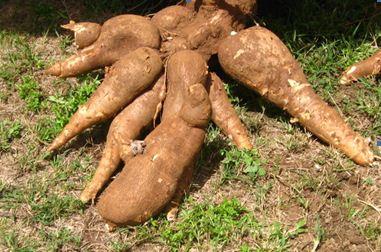 |
| Cassava KME 2, 6 months old |
|
© A.A.Seif, icipe
|
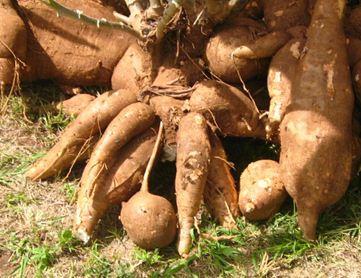 |
| Cassava KME 2, 12 months |
|
© A.A.Seif, icipe
|
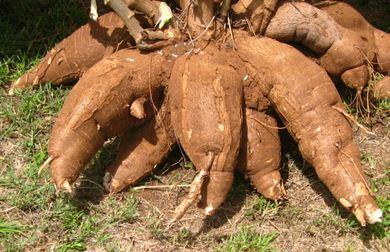 |
| Cassava KME 2, 18 months old |
|
© A.A.Seif, icipe
|
For more information on these varieties please contact the Kenya Agriculture and Livestock Research Organization (KALRO).
Cassava varieties in coastal and eastern Kenya (KALRO/KEPHIS)
| Variety | Optimal production altitude range (masl) (region) | Maturity (months) | Tuber yield (t/ha) | Special attributes |
| "5543/156" | 1-500 (coast/eastern lowlands) | 10-12 | 40-50 | Tolerant to ACMD; bitter |
| "Guso" | 1-700 (coast/eastern lowlands) | 12-15 | 20-40 | Resistant to (ACMD); sweet |
| "Kaleso" ("46106/27") | 1-1500 (coast /eastern) | 10-12 | 25-30 | Tolerant to ACMD and cassava brown streak disease (CBSD); sweet |
| "Karembo" ("KME-08-05") | 15-1200 (coast/eastern) | 8 | 50-70 | Tolerant to ACMD and CBSD; sweet; short with open structure |
| "Karibuni" ("KME-08-01") | 15-1200 (coast/eastern) | 8-12 | 50-70 | Tolerant to ACMD and CBSD; sweet; high branching; good for intercropping |
| "Kibanda Meno" | 1-500 | 6-8 | 20-30 | Very susceptible to ACMD,; very sweet |
| "KME 1" | 250-1500 (eastern) | 12-14 | 20 | Sweet |
| "KME 2" | 250-1500 (eastern) | 8-10 | 40 | Tolerant to ACMD; sweet |
| "KME 3" | 250-1500 (eastern) | 8-10 | 40 | Tolerant to ACMD; sweet |
| "KME 4" | 250-1500 (eastern) | 8-10 | 40 | Tolerant to ACMD; sweet |
| "KME 61" | 250-1500 (eastern) | 14 | 35 | Tolerant to ACMD; bitter |
| "Mucericeri" | 250-1750 (eastern) | 12-14 | 20 | Sweet |
| "Nzalauka" ("KME-08-06") | 15-1200 (coast/eastern) | 6-8 | 50-70 | Tolerant to ACMD and CBSD; sweet; straight stems ideal for intercropping |
| "Shibe" ("KME-08-04") | 15-1200 (coast/eastern) | 8-12 | 50-70 | Tolerant to ACMD and CBSD; sweet; straight stems ideal for intercropping |
| "Siri" | 15-1200 (coast/eastern) | 8-12 | 50 | Tolerant to ACMD and CBSD; sweet; very short without branches |
| "Tajirika" ("KME-08-02") | 15-1200 (coast/eastern) | 8 | 50-70 | Tolerant to ACMD and CBSD; sweet; straight stems ideal for intercropping |
Examples of cassava varieties grown in Tanzania (varieties listed are resistant/tolerant to ACMD)
- "Kachaga"
- "191/0057"
- "191/0063"
- "191/0067"
- "MM 96/0876"
- "MM 96/3075B"
- "MM 96/4619"
- "MM 96/4684"
- "MM 96/5725"
- "MM 96/8233"
- "MM 96/8450"
- "SS 4"
- "TME 14"
- "TMS 4(2)1425"
Examples of cassava varieties grown in Uganda (varieties listed are resistant/tolerant to ACMD)
- "Migyeera"
- "NASE 1 to 12"
- "SS 4"
- "TME 14"
- "TMS 4(2)1425"
- "TMS 192/0067"
- "TMS 50395"
- "Uganda MH 97/2961"
Nutritive value per 100 g of edible portion
| Raw or Cooked Cassava |
Food Energy (Calories / %Daily Value*) |
Carbohydrates (g / %DV) | Fat (g / %DV) | Protein (g / %DV) | Calcium (g / %DV) | Phosphorus (mg / %DV) | Iron (mg / %DV) | Potassium (mg / %DV) | Vitamin A (I.U) | Vitamin C (I.U) | Vitamin B 6 (I.U) | Vitamin B 12 (I.U) | Thiamine (mg / %DV) | Riboflavin (mg / %DV) | Ash (g / %DV) |
| Cassava raw | 160 / 8% | 38.1 / 13% | 0.3 / 0% | 1.4 / 3% | 16.0 / 2% | 27.0 / 3% | 0.3 / 1% | 271 / 8% | 13.0 IU / 0% | 20.6 / 34% | 0.1 / 4% | 0.0 / 0% | 0.1 / 6% | 0.0 / 3% | 0.6 |
*Percent Daily Values (DV) are based on a 2000 calorie diet. Your daily values may be higher or lower, depending on your calorie needs.
Propagation and planting
Propagation from storage roots is impossible, as the roots have no buds. Cassava is propagated through cuttings. The most suitable cuttings are 20-30 cm long and 20-25 mm in diameter (with 5-8 nodes), preferably from the middle browned-skinned portion of the stems of plants 8-14 months old. Cuttings from older, more mature parts of the stem give better yield than cuttings from younger parts, and long cuttings give higher yields than short cuttings. Select cuttings from healthy plants. Cuttings slightly infested with pests can be treated by immersion in heated water (mixing equal volumes of boiling and cold water) for 5-10 minutes just before planting.
The interval between cutting stems and planting should be as short as possible (not more than a couple of days). Cassava cuttings may be planted vertically, at an angle, or horizontally. The drier the soil the bigger the part of the stem placed in the soil. Under very dry conditions, plant cuttings at an angle and cover the larger part with soil. Vertical planting is best in sandy soils, as the roots develop deeper in the soil. Horizontal planting leads to a large number of thin stems, which may cause lodging. Moreover, the roots develop more closely to the surface and are more likely to be exposed and attacked by rodents and birds. Do not plant cuttings upside down, as this drastically reduces yield.
The spacing between plants will depend on whether cassava is grown as a sole crop or with other crops (intercropping). If cassava is being grown alone, plants should be planted 1 meter apart from each other. This means that 10.000 cuttings are required for 1 ha (4000 cuttings per acre). If cassava is being grown as an intercrop, the branching habit of both the cassava and the other crops should be considered, making sure there is enough space for the plants.
The best land for planting cassava is flat or gently sloping land. Steep slopes are easily eroded. Valleys and depression areas that usually get waterlogged are not very suitable and cassava roots do not develop well. Before planting get to know the history of the land (previous crops, types of weeds, diseases and pests).
Soil preparation varies from practically zero under shifting cultivation to ploughing, harrowing and possible ridging in more intensive cropping systems. Planting on mounds and ridges is recommended, especially for areas with rainfall of more than 1200 mm per year or in areas where soils get waterlogged (e.g. valleys and depressions). Ridging may not give higher yield, but harvesting is easier and soil erosion may be reduced, especially by contoured ridges. In sandy soils, minimum tillage and planting cassava on the flat are appropriate. Plant at the beginning of the rainy season.
Husbandry
Weeding is necessary every 3-4 weeks until 2-3 months after planting. Afterwards the canopy may cover the soil and weeding is less necessary. Although cassava grows rather well on poor soils, it requires large amount of nutrients to produce high yields. To maintain high yields, it is necessary to maintain the fertility of the soil. Phosphorous is important for root development. Symptoms of phosphorous deficiency are stunted growth and violet or purple discolouration of the leaves. In the absence of good compost, rock phosphate can be applied if needed. Potassium is also needed by cassava and can be applied in the form of compost or wood ashes. Potassium deficiency symptoms are: stunted growth, dark leaf colour which gradually becomes paler, dry brown spots on tips and margins of the leaves and "burnt" edges of leaves.
Fertilisers and manures are usually not used by small-scale cassava growers in most African countries because, in many cases, they cannot afford such additional inputs. However, it is important to provide good growing conditions for the plants, as healthy plants are able to withstand some damage by pests and diseases. In general, cassava responds well to farmyard manure. Manure can be applied at land preparation to increase soil nutrients, to improve the soil structure, and to improve the ability of the soil to hold water.
Mulching cassava, especially after planting, is helpful when growing cassava in dry areas or on slopes.
Crop rotation and intercropping
There is a wide variety of cropping patterns and rotations with cassava. Though rotation with other crops is preferable, cassava is sometimes grown continuously on the same land, especially in dry areas not suitable for other crops. When grown in bush-fallow systems, cassava is usually planted at the end of the rotation cycle, as it still produces relatively well at lower fertility levels and also allows a smooth transition to the fallow.
Cassava when planted as an intercrop along with cowpea groundnut or tree crops like Leucaena reduces soil run-off and soil-loss. Forage yield of Leucaena improves when grown with cassava and groundnut. Canavalia or Crotalaria (legume crops) when planted as intercrops with cassava improves soil productivity.
Sow 1 row of Canavalia or Crotalaria between rows of cassava immediately after planting cassava. Let these grow until harvest. Plough after harvest to incorporate crop residues into the soil.
Harvesting
Harvesting is done either piece-meal or by uprooting whole plants. Young plants are usually harvested piece-meal, while old plants are more commonly uprooted to prevent the storage roots becoming very fibrous. As cassava roots do not keep fresh more than 2-3 days after harvesting, not all plants are harvested at once, but rather harvesting as the roots are consumed. When cassava is grown for urban markets they are harvested in bulk. Cassava is usually harvested 9-12 months after planting. It is sometimes harvested earlier if needed for food. Storage roots become too woody if harvesting is delayed. Early maturing varieties are ready for harvesting at 6 months while late maturing varieties are ready 12 months after planting.
Storage
Cassava does not store well when fresh and therefore has to be peeled, chopped and dried in the sun. It can then be stored in the form of chips or flour under dry conditions.
Average yields are between 3-4 tons of fresh tubers per acre (7.5-10 tons per ha) although with reasonable care and attention yields of up to 10 tons per acre (25 tons per ha) and more are possible. The ratio of fresh tubers to peeled and dried chips is about 3:1.
Marketing
Manual from IITA Starting a cassava farm Of the world production of cassava, 65% is used directly for human consumption, 20% for animal feed and the remaining 15% for starch and industrial uses (alcohol production). In Africa, stems are often used as firewood.
Climate conditions, soil and water management
In equatorial areas, cassava can be grown up to 1500 m altitude. The optimum temperature range is 20-30°. Specific cultivars are necessary for successful cultivation at an average temperature of 20°. Cassava is grown in regions with 500-6000 mm of rainfall per year. Optimum annual rainfall is 1000-1500 mm, without distinct dry periods. Once established, cassava can resist severe drought. With prolonged periods of drought, cassava plants shed their leaves but resume growth after the rains start, making it a suitable crop in areas with uncertain rainfall distribution. Because of its drought resistance, in many regions cassava is planted as a reserve crop against famine in dry years. Good drainage is essential for cassava; the crop does not tolerate water logging. High irradiance is preferred.
Best growth and yield are obtained on fertile sandy loams. Cassava is able to produce reasonable yields on severely depleted or even eroded soils where other crops fail. Gravelly or stony soils cause problems with root penetration and are unsuitable. Also heavy clay or other poorly drained soils are not suitable.
Cassava growth and yield are reduced drastically on saline soils and on alkaline soils with a pH above 8.0. The optimum pH is between 5.5 and 7.5, but cultivars are available that tolerate a pH as low as 4.6 or as high as 8.0. Reasonably salt-tolerant cultivars have also been selected. Very fertile soils encourage excessive foliage growth at the expense of storage roots.
Information on Pests
Furthermore, many cassava varieties contain cyanogenic glucosides, and inadequate processing can lead to high toxicity. Various processing methods, such as grating, sun drying, and fermenting, are used to reduce the cyanide content.
| Cassava mealybug (Phenacoccus manihoti) The cassava mealybug is pinkish in colour. Its body is surrounded by very short filaments, and covered with a fine coating of wax. Adults are 0.5-1.4 mm long. This mealybug does not have males. Females live for about 20 days and lay 400 eggs in average. The lifecycle from egg to adult is completed in about 1 month at 27°C. It reproduces throughout the year and it reaches peak densities during the dry season. Mealybugs are dispersed by wind and through planting material.
The cassava mealybug strongly prefers cassava and other Manihot species; other host crops and wild hosts are only marginally infested. It sucks sap at cassava shoot tips, on the lower surface of leaves, and on stems. During feeding the mealybug injects a toxin into the cassava plant causing deformation of terminal shoots, which become stunted, resulting in compression of terminal leaves into "bunchy tops". The length of internodes is reduced, and stems are distorted. When attack is severe plants die, starting at the plant tip, where most mealybugs are found.
Mealybug attack results in leaf loss and poor quality planting material (stem cuttings) due to dieback and weakening of stems used for crop propagation. Tuber losses have been estimated up to 80%. The pest-induced defoliation reduces availability of healthy leaves, which are consumed as leafy vegetables in most of West and Central Africa. After the pest cripples plant growth, weed and erosion sometimes lead to total destruction of the crops. In general, yield losses depend upon age of plant when attacked, length of dry season, severity of attack and general conditions of the plant. Mealybug damage is more severe in the dry than in the wet season.
The cassava mealybug was accidentally introduced to Africa from South America. After the first reports in the 1970s, the insect became the major cassava pest within a few years and spread rapidly through most of the African cassava belt. The outbreak led to famine in several countries where cassava is a staple crop and particularly important in times of drought. In an attempt to control this pest natural enemies, mainly parasitic wasps and ladybird beetles, were introduced from South America.
The most effective has been the parasitic wasp (Apoanagyrus (=Epidinocarsis) lopezi), which has kept this mealybug at low levels, resulting on significant reduction of yield losses in most areas in Africa (Neuenschwander, 2003). What to do:
|
| Larger grain borer (Prostephanus truncatus) The larger grain borer has been found infesting cassava chips in storage particularly during the rainy season in West Africa. This beetle is currently the most serious pest of dried cassava in storage. Weight losses as high as 70% after 4 months of storage have been reported elsewhere. What to do:
For more information on Neem click here. |
| Birds and other vertebrate pests Birds, rodents, monkeys, pigs and domestic animals (cattle, goat and sheep) are common vertebrate pests of cassava.
Measures that help to manage damage by these pests include: What to do:
|
| Striped mealybug (Ferrisia virgata) It is a whitish mealybug with two longitudinal dark stripes, long glassy wax threads and two long tails. It attains a length of 4 mm. The stripped mealybug occurs on the underside of leaves near the petioles and on the stems. It sucks sap but does not inject any toxin into plants. Severely attacked plants show general symptoms of weakening but do not show distortion. It is a minor pest of cassava, and no control is usually required as is controlled naturally by natural enemies. What to do:
|
| Cassava green spider mite (Mononychellus tanajoa or M. progresivus) This mite is green in colour at a young age turning yellowish as adult. Adult females attain a size of 0.8 mm. They appear as yellowish green specks to the naked eye. They occur on the lower surface of young leaves, green stems and auxiliary buds of cassava. Damage initially appears as yellowish "pinpricks" on the surface of young leaves.
Symptoms vary from a few chlorotic spots to complete chlorosis. These symptoms are somehow similar to African cassava mosaic disease, and should not be confused. Heavily attacked leaves are stunted and become deformed. Severe attacks cause the terminal leaves to die and drop, and the shoot tip looks like a "candle stick". Green spider mites are major pests in dry season. Severe mite attack results in 20-80 % loss in tuber yield.
Predatory mites (mainly Typhlodromalus aripo and T. manihoti) introduced from South America, the home of the cassava green mite, have given effective control of the cassava green mites in Africa (Yaninek and Hanna, 2003).
What to do:
|
| Red spider mites (Oligonychus gossypii and Tetranychus spp.) Several species of red spider mites also occur on cassava, mostly on the older leaves. Adults are about 0.6 mm long. Initial symptoms are yellowish pinpricks along the main vein of mature leaves. Spider mites produce protective webbing that can be readily seen on the plant. Attacked leaves turn reddish, brown or rusty in colour. Under severe mite attack, leaves die and drop beginning with older leaves. Most damage occurs at the beginning of the dry season. What to do:
|
| Cassava scales (Aonidomytilus albus) It is a mussel-shaped scale with an elongated silvery-white cover and about 2-2.5 mm long. This scale may cover the stem with conspicuous white secretions, and eventually the leaves. This scale sucks from the stem and dehydrates it. The leaves of attacked plants turn pale, wilt and drop off. Severely attacked plants are stunted and yield poorly. Scale attack can kill cassava plants, in particular plants weakened by previous insect attack and drought. Stem cuttings derived from infested stem portions normally do not sprout. What to do:
|
| Grasshoppers (Zonocerus variegatus) Grasshoppers such as the variegated grasshopper (West to East Africa south of the Sahara), and the elegant grasshopper (Z. elegans) (Southern Africa and East Africa) are brightly coloured grasshoppers.
Adults are dark green with yellow, black and orange marking on their bodies. Nymphs are black with yellow markings on the body, legs and antenna and wing pads. Female grasshoppers lay many eggs just below the surface of the soil in the shade under evergreen plants, usually outside cassava fields. Eggs are laid in masses of froth, which harden to form sponge-like packets, known as egg pods, which look like tiny groundnut pods. Eggs start to hatch at the beginning of the main dry season.
Grasshoppers attack a wide range of crops mainly in the seedling stage. They feed on cassava plants, chewing leaves and stems and may cause defoliation and debark stems. This is particularly severe in fields next to the bush when the dry season is prolonged. What to do:
|
| Whiteflies (Bemisia tabaci, Aleurodicus dispersus) Several species of whiteflies are found on cassava in Africa. Feeding causes direct damage, which may cause considerable reduction in root yield if prolonged feeding occurs. Some whiteflies cause major damage to cassava as vectors of cassava viruses. The spiralling whitefly (Aleurodicus dispersus) was reported as a new pest of cassava in West Africa in the early 90s. The adults and nymphs of this whitefly occur in large numbers on the lower surfaces of leaves covered with large amount of white waxy material. Females lay eggs on the lower leaf surface in spiral patterns (like fingerprints) of white material secreted by the female. This whitefly sucks sap from cassava leaves. It excretes large amounts of honeydew, which supports the growth of black sooty mould on the plant, causing premature fall of older leaves.
The tobacco whitefly (Bemisia tabaci) transmits the African cassava mosaic virus, one of the most important factors limiting production in Africa. The adults and nymphs of the tobacco whitefly occur on the lower surface of young leaves. They are not covered with white material. The nymphs appear as pale yellow oval specks to the naked eye. What to do:
|
| Different species of termites damage cassava stems and roots. Termites damage cassava planted late or in the dry season, in particular when the crop is still young at the peak of the dry season. They chew and eat stem cuttings which grow poorly, die and rot. The may destroy whole plantations. In older cassava plants termites chew and enter the stems. This weakens the stems and causes them to break easily. What to do:
|
| A number of beetles feed on dry cassava causing post harvest losses. In Benin Republic the most common are Dinoderus sp., Carpophilus sp., the coffee bean weevil (Araecerus fasciculatus), the lesser grain borer (Rhizopertha dominica), and more recently, the larger grain borer (Prostephanus truncatus).
Infestation by these insects is heavier in the rainy season than in the dry season, is more prevalent in the humid zone than in the savannah, and is found more in large chips than in smaller ones. Maximum infestation was found after 6 to 8 months in storage, at which time chips would fall into dust when squeezed (Bokanga, IITA, FAO).
What to do:
For more information on Neem click here. |
| African Cassava Mosaic Disease (ACMD) African cassava mosaic disease is one of the most serious and widespread diseases throughout cassava growing areas in Africa, causing yield reductions of up to 90%. It is spread through infected cuttings and by whiteflies (Bemisia tabaci).
Symptoms occur as characteristic leaf mosaic patterns that affect discrete areas and are determined at an early stage of leaf development. Symptoms vary from leaf to leaf, shoot to shoot and plant to plant, even of the same variety and virus strain in the same locality. Some leaves situated between affected ones may seem normal and give the appearance of recovery. What to do:
|
| Cassava bacterial blight (Xanthomonas campestris pv. manihotis) It is a major constraint to cassava cultivation in Africa. Infected leaves show localised, angular, water-soaked areas. Under severe disease attack heavy defoliation occurs, leaving bare stems, referred to as "candle sticks". Since the disease is systemic, infected stems and roots show brownish discolouration. During periods of high humidity, bacterial exudation (appears as gum) can readily be observed on the lower leaf surfaces of infected leaves and on the petioles and stems. The disease is favoured by wet conditions. This disease is primarily spread by infected cuttings. It can also be mechanically transmitted by raindrops, use of contaminated farm tools (e.g. knives), chewing insects (e.g. grasshoppers) and movement of man and animals through plantations, especially during or after rain. Yield loss due to the disease may range from 20 to 100% depending on variety, bacterial strain and environmental conditions. What to do:
|
| Brown leaf spot (Cercosporidium henningsii) Symptoms are restricted to older leaves. Brownish round spots with definite borders appear on the upper leaf surface. On the lower leaf surface, they are brownish-grey in colour. Infected leaves later become yellow and eventually drop. In wet areas the disease may cause a yield reduction of up to 20%. What to do:
|
| Cassava brown streak virus disease (Potyvirus - Potyviridae) It is particularly serious in coastal areas of Kenya, Zanzibar, Mozambique and Tanzania and lakeshore region of Malawi and in Uganda and is a threat to the whole of sub-Saharan Africa. The virus is vectored by whiteflies (Bemisia spp.) and also transmitted through infected cuttings. Symptoms include yellowing (leaf chlorosis) and brown streaks in the stem bark (cortex). Infected tubers have brown streaks (root necrosis) (Field Crops Technical Handbook, MoA, Kenya). It's a stealth virus, which destroys everything in the field. The leaves may appear healthy even when the roots have rotted away.
What to do:
|
| Anthracnose (Glomerella manihotis) Initial symptoms of the disease are oval lesions ("sores") on young stems. On older stems, raised fibrous lesions develop that eventually become sunken.
What to do:
|
| Some fungi growth on cassava chips, usually when the moisture content of cassava chips exceeds 14%, making them unfit for feed and food. A survey of cassava chips processing areas of West Africa has indicated that the most common fungi were Rhizopus sp. and Aspergillus sp. (IITA, 1996).
What to do:
For more information on Storage pests click here. |
Information Source Links
- AIC (2002). Field Crops Technical Handbook, Ministry of Agriculture and Rural Development, Nairobi, Kenya.
- Bellotti, A., Smith, L., Lapointe S. (1999). Recent advances in cassava pest management. Annu. Rev. Entomol. 44: 343-70.
- Bohlen, E. (1973). Crop pests in Tanzania and their control. Federal Agency for Economic Cooperation (bfe). Verlag Paul Parey. ISBN: 3-489-64826-9
- CAB International (2005). Crop Protection Compendium, 2005 edition. Wallingford, UK www.cabi.org
- Ezulike, T.O., Egwuatu RI. (1993). Effects of intercropping cassava and pigeon pea on green spider mite Mononychellus tanajoa (Bondar) infestations and on yields of the associated crops. Discovery and Innovations, 5:355-359.
- ICTVdB Management (2006). 00.057.0.71.002. Cassava brown streak virus. In: ICTVdB - The Universal Virus Database, Columbia University, New York, USA. ICTVdB - The Universal Virus Database http://ictvonline.org
- INPhO. Post-harvest Compendium. Cassava. www.fao.org
- James, B., Yaninek, J., Neuenschwander, P. Cudjoe, A., Modder, W., Echendu, N. and Toko, M. (2000). Pest control in cassava farms. International Institute of Tropical Agriculture (IITA). ISBN: 978-131-174-6 www.iita.org
- James, B., Yaninek, J., Tumanteh, A., Maroya, N., Dixon, A.R. and Kwarteng, J. (2000). Starting a cassava farm. International Institute of Tropical Agriculture (IITA). ISBN: 978-131-173-8 See also online under www.iita.org
- Msikita, W., James, B., Nnodu, E., Legg, J., Wydra, K. and Ogbe, F. (2000). Disease control in cassava farms. International Institute of Tropical Agriculture (IITA). ISBN: 978-131-176-2 www.iita.org
- Natural Resources International Ltd (2004). DFID Renewable Resources Research Strategy Annual Reports for 2003-2004 for Crop Post-Harvest, Crop Protection, Forestry Research, Livestock Production and Post-Harvest Fisheries research Programmes. Natural Resources International Limited, Aylesford, Kent, UK. (CD-ROM)
- Neuenschwander, P. (1998). Impact of two accidentally introduced Encarsia species (Hymenoptera: Aphelinidae) and other biotic and abiotic factors on the spiralling whitefly (Aleurodicus dispersus (Russell) (Homoptera: Aleyrodidae), in Benin, West Africa. Biocontrol Science and Technology. 8, 163-173.
- Neuenschwander, P. (2003). Biological control of cassava and mango mealybugs. In Biological Control in IPM Systems in Africa. Neuenschwander, P., Borgemeister, C and Langewald. J. (Editors). CABI Publishing in association with the ACP-EU Technical Centre for Agricultural and Rural Cooperation (CTA) and the Swiss Agency for Development and Cooperation (SDC). pp. 45-59. ISBN: 0-85199-639-6
- Nicol, C. M. Y., Assadsolimani, D. C. and Langewald, J. (1995). Caelifera: Short-horned grasshoppers and locust. In "The neem tree Azadirachta indica A. Juss. And other meliaceous plants sources of unique natural products for integrated pest management, industry and other purposes". Pp. 233- Edited by H. Schmutterer in collaboration with K. R. S. Ascher, M. B. Isman, M. Jacobson, C. M. Ketkar, W. Kraus, H. Rembolt, and R.C. Saxena. VCH. ISBN: 3-527-30054-6 r ISBN
- Nutrition Data www.nutritiondata.com.
- Olaifa, J. I., Adenuga, A. O. (1988). Neem products for protecting field cassava from grasshopper damage. Insect Science. Appl. Vol. 9, No.2, pp 267-270.
- Plant Protection and Regulatory Services Directorate (PPRSD) (2000). Handbook of crop protection recommendations in Ghana: An IPM approach. Vol. 3: Root and Tuber Crops, Plantains. E. Blay, A. R. Cudjoe and M. Braun (Editors). Published by PPRSD with support of the German Development Cooperation (GTZ). ISBN: 9988-8025-6-0
- Théberge, R.L. (Ed) (1985). Common African pests and diseases of cassava, yam, sweet potato and cocoyam. International Institute of Tropical Agriculture, IITA Ibadan, Nigeria. ISBN: 978-131-001-4
- Yaninek, S., Hanna, R. (2003). Cassava green mite in Africa-a Unique Example of Successful Classical Biological Control of a Mite Pest on a Continental Scale. In Biological Control in IPM Systems in Africa. Neuenschwander, P., Borgemeister, C and Langewald. J. (Editors). CABI Publishing in association with the ACP-EU Technical Centre for Agricultural and Rural Cooperation (CTA) and the Swiss Agency for Development and Cooperation (SDC). pp. 61-75. ISBN: 0-85199-639-6

